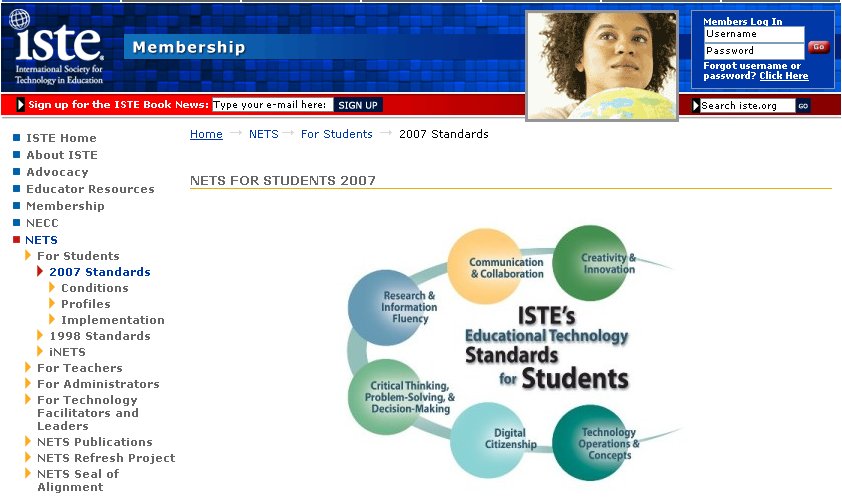NETS-S學生的教育科技指標2007~數位時代的全球學習
作者: 塾長 日期: 2008-07-20 15:43
美國的教育科技標準與績效指標(National Educational Technology Standards),分別從學生(NETS-S) 、教師(NETS-T) 與行政領導(NETS-A) 、科技促進與領導團隊 層面,列舉相關主題和指標。這次來ISTE網站,正逢學生版自1998更新到2007版,而老師版也從2000更新到2008年版,行政端,則要到2009才會公佈新版。我喜歡這種規劃:學生表現這樣時,老師也該準備好並支持,老師教學需要的支持,行政就要準備好並支持與督導!

首先提出個人對學生版的新舊版本看法。
1998年,也相當於擴大內需之時,指標以『工具操作之熟悉與應用』為主,分別有六大項:
1.基本操作與概念、2.社會、倫理和人類課題、3.科技生產工具、4.科技傳播工具、5.科技研究工具、6.科技解決問題和決策工具
而到了2007年,科技已成為生活中不可或缺的一環,孩子們更可能比大人上手許多,新版的指標強調『善用科技表現、分享與群球視野』,也有六大項:
1.創造力和創新、2.溝通和合作、3.研究和資訊流暢、4.批判思考,問題解決和做決策、5.數位公民、6.科技操作和概念
(呵呵,跟自己之前分析webquest的task類型 有點像呢!)
新版的每個大項各有細部描述,未免翻譯出入,我並列原文給大家參考,也歡迎多多指教喔!以下先介紹學生版的教育科技指標:
1.創造力和創新
學生表現出創造性思考,建構知識,利用科技發展創新產品和流程。學生:
a.應用既有的知識產生新的想法,產品或過程。
b.建立可代表個人或小組的原創作品。
c.使用模型和模擬來探討複雜系統和問題。
d.發現趨勢和預測可能性。
1.Creativity and Innovation
Students demonstrate creative thinking, construct knowledge, and develop innovative products and processes using technology. Students:
a.apply existing knowledge to generate new ideas, products, or processes.
b.create original works as a means of personal or group expression.
c.use models and simulations to explore complex systems and issues.
d.identify trends and forecast possibilities.
2.溝通和合作
學生利用數位媒體和環境進行溝通與協同合作,包括遠距地支持個別的學習,並對他人的學習提供幫助。學生:
a.利用各種數位環境和媒體,與同儕,專家,或他人互動,合作,出版(發表)。
b.利用各種媒體和型式,有效地與多人溝通信息和想法。
c.藉由與其他文化的學習者互動,發展對文化的理解和全球意識。
d.藉由製作原創作品,或解決問題,對專題團隊作出貢獻。
2.Communication and Collaboration
Students use digital media and environments to communicate and work collaboratively, including at a distance, to support individual learning and contribute to the learning of others. Students:
a. interact, collaborate, and publish with peers, experts, or others employing a variety of digital environments and media.
b. communicate information and ideas effectively to multiple audiences using a variety of media and formats.
c. develop cultural understanding and global awareness by engaging with learners of other cultures.
d. contribute to project teams to produce original works or solve problems.
3.研究和資訊流暢
學生使用數位工具,以收集,評估和使用資訊。學生:
a規劃策略以引導探究。
b.查找,組織,分析,評估,綜合,並能從不同的來源和媒體合乎道德地使用資訊。
c. 基於對具體任務的適切考量,評估和選擇資訊來源與數位工具。
d.處理資料和報告結果。
3. Research and Information Fluency
Students apply digital tools to gather, evaluate, and use information. Students:
a.plan strategies to guide inquiry. b.locate, organize, analyze, evaluate, synthesize, and ethically use information from a variety of sources and media. d.process data and report results.
c.evaluate and select information sources and digital tools based on the appropriateness to specific tasks.
4.批判思考,問題解決和做決策
學生使用批判性思考技能,以計劃和進行研究,管理專題,解決問題,並利用適當的數化工具和資源作出明智的決定。學生:
a.確定和界定所要研究的真實問題和重大問題。
b.計劃和管理活動,以發展解答或完成專題。
c.收集和分析數據,以確定解決方案和/或作出明智的決定。
d.使用多元過程和不同的觀點來探討不同的解決辦法。
4.Critical Thinking, Problem Solving, and Decision Making
Students use critical thinking skills to plan and conduct research, manage projects, solve problems, and make informed decisions using appropriate digital tools and resources. Students:
a. identify and define authentic problems and significant questions for investigation.
b. plan and manage activities to develop a solution or complete a project.
c. collect and analyze data to identify solutions and/or make informed decisions.
d. use multiple processes and diverse perspectives to explore alternative solutions.
5.數位公民 學生了解與科技相關的人類,文化和社會問題,並能實踐符合法律和道德的行為。學生:
a.倡導和實踐的安全,合法和負責任地使用資訊和科技。
b.展現積極的態度,應用科技來支持合作,學習和表現生產力。
c.顯示個人終身學習的責任。
d.展現對數位公民的權領力。
5. Digital Citizenship
Students understand human, cultural, and societal issues related to technology and practice legal and ethical behavior. Students:
a. advocate and practice safe, legal, and responsible use of information and technology.
b. exhibit a positive attitude toward using technology that supports collaboration, learning, and productivity. c. demonstrate personal responsibility for lifelong learning.
d. exhibit leadership for digital citizenship.
6.科技操作和概念
學生表現出對科技概念、系統與操作的良好認識,觀念,技術,制度和行動。學生:
a.理解和使用科技系統。
b. 有效和有成果地選擇和使用科技應用。
c.對系統與應用的障礙排除。
d.轉換現有知識到新技術的學習。
6. Technology Operations and Concepts
Students demonstrate a sound understanding of technology concepts, systems, and operations. Students:
a. understand and use technology systems.b. select and use applications effectively and productively.
c. troubleshoot systems and applications.d. transfer current knowledge to learning of new technologies.
除了上述描述,也有4~18歲分四段的ICT行動細述(profiles) 喔!乖乖,這回從4~8歲就開始耶,或許值得商榷;但,現在的小孩上網已經跟開冰箱一樣自然不是嗎? 倒是,我們也可以對應著發展家長的指標(年輕一點的爸爸媽媽們,都可能已是線上遊戲玩家了...)
 訂閱
訂閱 上一篇
上一篇 返回
返回 下一篇
下一篇

 標籤:
標籤:


18年數位原生能力轉變與期待 (2016-07-02 17:18)
NETS-A校長的教育科技指標2009~教育轉化 (2009-11-09 21:47)
NETS-T老師的教育科技指標2008~支持數位時代的學習者 (2008-07-20 16:16)